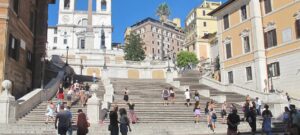From Palatial Building to Party Zone
It serves as a backdrop for movies, holds cherished memories of youth, and is a must-visit spot for tourists. The Spanish Steps, a unique Baroque monument in the heart of Rome, began its construction 300 years ago. The best time to visit the Spanish Steps is early morning, especially during the summer when the morning light highlights the grand structure. It is a time when tourist groups have not yet crowded the steps, scrambling to capture iconic selfies. “Us and the steps,” they say.
Angela and her family of four from Detroit didn’t manage to arrive quite so early. It is 9 o’clock, already too hot to climb the 136 steps to the top. So they take the obligatory self-portrait at the Piazza di Spagna, gazing up at the end of the Spanish Steps. “I find them truly beautiful,” says Angela. She appreciates the outline of the steps and the fact that they curve upwards from the middle level. “It reminds me of San Francisco.”
Ascending the Muddy Slope
For art historian Susanne Kubersky, the Spanish Steps are part of her daily commute to work. She arrives at the bottom via the metro and then climbs the steps to reach her office. “That’s exactly what I love so much,” says the scholar. “Every morning, I have the privilege of ascending this beautiful staircase and reflecting on the fact that I am traversing 2,000 years of Roman history.”
Kubersky works at the “Bibliotheca Hertziana,” the Max Planck Institute for Art History in Rome, which resides in the prestigious neighborhood at the peak of the Spanish Steps. The area was once the location of the villa belonging to the Roman general Lucullus, hence the 2,000 years of Roman history. Today, it is occupied by the famous Hotel Hassler and the church that the steps actually lead to: the Santissima Trinita dei Monti, built in 1587.
“To reach this church, one had to ascend a muddy slope under trees,” explains Kubersky. The idea of building the staircase to facilitate the climb had been considered for a long time. “But it was actually executed during the Baroque period in the 18th century, planned as a scenographic structure. So it truly is a magnificent staircase.”
France Sponsored its Construction
The construction of the Spanish Steps began in 1723. Architect Francesco de Sanctis aimed not only to overcome a vertical distance of 23 meters but also to create a stage, 40 meters wide, as a display of power. The construction was largely sponsored by France, the protectorate of the popes. Initially, King Louis XIV of France himself was supposed to be depicted at the top of the staircase in the form of an equestrian statue. However, the Pope found it to be excessive display of power.
Today, the Spanish Steps serve a very different purpose. In the evening, it transforms into a party zone. “It is a meeting point that nobody can miss and that everyone remembers,” says Kubersky. “And it is, of course, a place where young people enjoy sitting, meeting, and being approached.”
Partying on the Steps is Prohibited
However, there is one thing that should no longer be done: sitting on the steps, especially with a bottle of red wine, as was common during school trips in past decades. The city of Rome sanctions any attempts to party on the steps, as the ever-present policemen explain.
“Anyone who sits down can expect a fine of 450 euros,” explains one of the policemen. “It is even worse if someone defaces the monument. But we try to prevent anyone from paying 450 euros.”
If necessary, the policemen remind those who sit on the steps, with the help of a whistle, that it could soon become expensive. Only in the morning are they merciful and allow the few tourists to rest on the steps in the shade.





























































